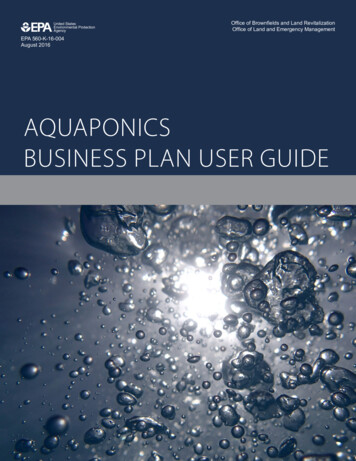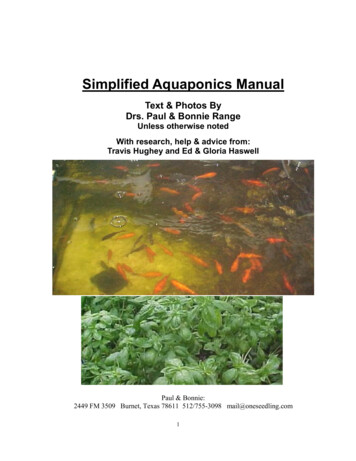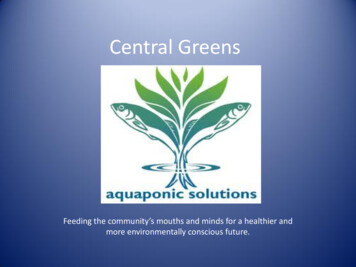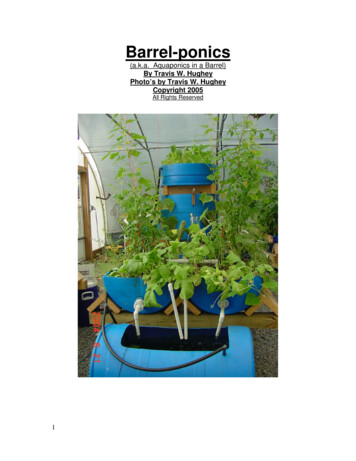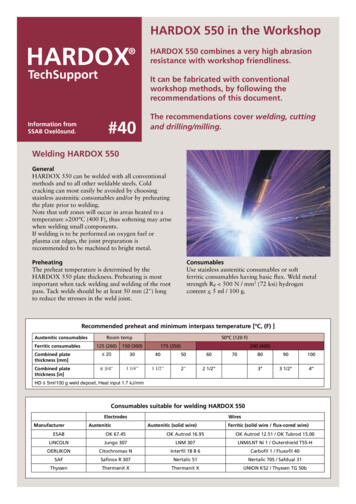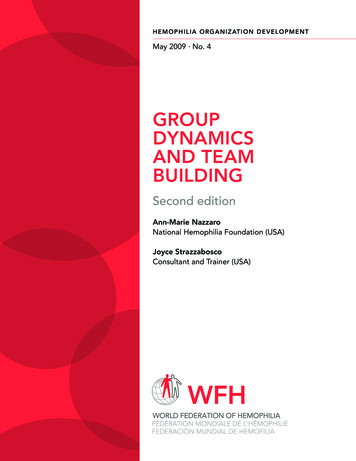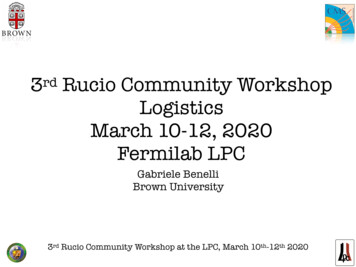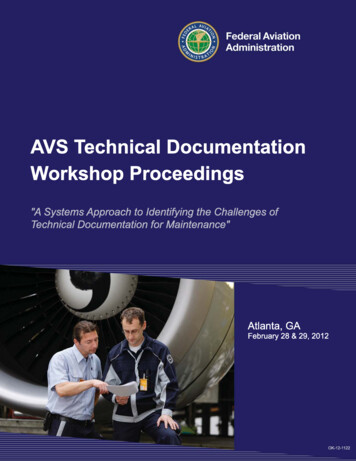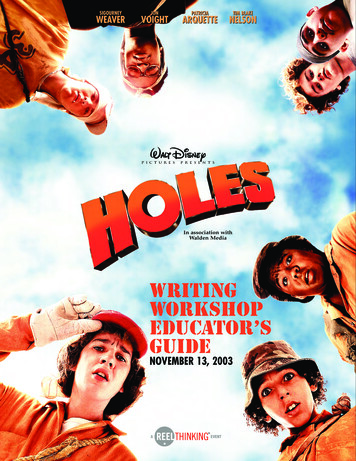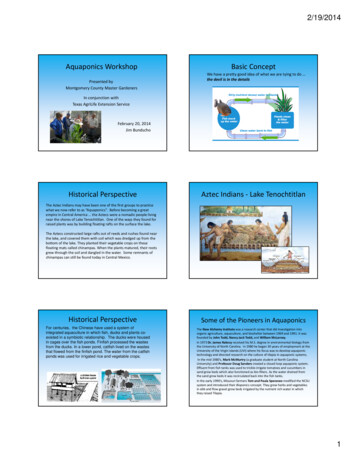
Transcription
2/19/2014Aquaponics WorkshopPresented byMontgomery County Master GardenersBasic ConceptWe have a pretty good idea of what we are tying to do the devil is in the detailsIn conjunction withTTexasA iLif ExtensionAgriLifeEi ServiceS iFebruary 20, 2014Jim BundschoHistorical PerspectiveAztec Indians ‐ Lake TenochtitlanThe Aztec Indians may have been one of the first groups to practicewhat we now refer to as “Aquaponics”. Before becoming a greatempire in Central America the Aztecs were a nomadic people livingnear the shores of Lake Tenochtitlan. One of the ways they found forraised plants was by building floating rafts on the surface the lake.The Aztecs constructed large rafts out of reeds and rushes found nearthe lake, and covered them with soil which was dredged up from thebottom of the lake. They planted their vegetable crops on thesefloating mats called chinampas. When the plants matured, their rootsgrew through the soil and dangled in the water. Some remnants ofchinampas can still be found today in Central Mexico.Historical PerspectiveFor centuries, the Chinese have used a system ofintegrated aquaculture in which fish, ducks and plants coexisted in a symbiotic relationship. The ducks were housedin cages over the fish ponds. Finfish processed the wastesfrom the ducks. In a lower pond, catfish lived on the wastesthat flowed from the finfish pond. The water from the catfishponds was used for irrigatedpgrice and vegetablegcrops.pSome of the Pioneers in AquaponicsThe New Alchemy Institute was a research center that did investigation intoorganic agriculture, aquaculture, and bioshelter between 1969 and 1991. It wasfounded by John Todd, Nancy Jack Todd, and William McLarney.In 1973 Dr. James Rakocy received his M.S. degree in environmental biology fromthe University of North Carolina. In 1980 he began 30 years of employment at theUniversity of the Virgin Islands (UVI) where his focus was to develop aquaponictechnology and directed research on the culture of tilapia in aquaponic systems.In the mid 1980’s, Mark McMurtry (a graduate student at North CarolinaUniversity) and Professor Doug Sanders created a closed loop aquaponic system.Effluent from fish tanks was used to trickle‐irrigate tomatoes and cucumbers insand grow beds which also functioned as bio‐filters. As the water drained fromthe sand grow beds it was recirculated back into the fish tanks.In the early 1990’s, Missouri farmers Tom and Paula Speraneo modified the NCSUsystem and introduced their Bioponics concept. They grew herbs and vegetablesin ebb and flow gravel grow beds irrigated by the nutrient rich water in whichthey raised Tilapia.1
2/19/2014What are we really talking about? In its most basic form Aquaponics is really a “waste watertreatment plant” Fish waste comes in plants grow and help to clean the water we eat the fish and the plants There are YEARS of data on how to treat waste water YEARSof data with Hydroponics and CENTURIES of experience withagriculture. We are just beginning to understand how smallscale integrated Aquaponic systems for homeowners might besized and managed properly.Why do we really want to do it? Once you get past the “Wow, that’s neat!” Why do we really wantto do it? The most rapidly growing segment in Aquaponics is the homeowner“back yard” system. The “Hydroponic” growers have acres of production for tomatoes,q psystemsyover 1 acre lettuce,, etc. There are veryy few Aquaponicand most are single operator, home based market gardeners, or“backyard” gardeners. Why?You can get 2 crops fish and vegetables.There is no weeding.Water consumption is less than conventional row crops. Production can beas good as or better than Hydroponics.Aquaponics vs. Hydroponics Hydroponics uses a nutrient solution based onspecific chemical compounds to optimize plantgrowth in a soil‐less medium Aquaponics also “uses”, or more accurately “creates”a nutrient solution based on fish waste and microbialactivity that more closely resembles natural processesin a healthy ecosystemWhy do we really want to do it?There are challenges however –High startup costs similar to HydroponicsBank financing is somewhat limited based on lack of proven financialhistoryFish need care these are live animals!On the other hand –You can set this up on an abandoned parking lot or a rooftopProtected environments mean lower weather risksNiche markets can be establishedAquaponic realitiesSystem Types Raft – Deep water culture Plants need a robust supply of nutrients Nutrients are supplied primarily as a result of fish waste andmineralized waste Addition of Calcium, Magnesium and small amounts of Iron iscommon Nitrifying bacteria and fish both need oxygen to survive and workproperly– UVI type systems Constant flow – proven success when managed properly Market gardener or Commercial scale Nutrient Film Technique – NFT– Commonly used in Hydroponics– Narrow channels of pipe Shallow stream of nutrient circulated through troughs Media beds – Solids removal and system management is needed– Flood and drain (ebb and flow)– Plants rooted into gravel or other media2
2/19/2014Raft type systemsRaft type systems Long beds up to 100’ lined with rubber membrane Beds must be level and plumbed back to sump Floatingg styrofoamysheets with plantingpg holes spacedpformaximum plant density Root cups support transplants until root system develops Air stones approximately every 4 ft. are required to maintaindissolved oxygen levels within raft bedsUVI System ModelUVI Early Design PrototypeNelson & Pade – Family SystemRaft type systemsNelson & Pade F5 Home package 2,995(1) 110 Gallon fish tank, (2) 3’ x 5’ grow beds(2) Rafts, Water pump and air pump, etc 3
2/19/2014NFT (Nutrient Film Technique)NFT (Nutrient Film Technique)Commerciallyavailable troughs PVC pipe may be anoption Long sloping channels of PVC or other material – 3” to 4”deep Removable top for easy cleaning Planting holes spaced for maximum planting density Root cups hold plants while root system develops Shallow stream of nutrient rich water in troughMedia beds – flood and drainMedia beds – flood and drain Deep media beds – approximately 12” Material used varies by preferenceo Washed river gravel (heavy but inexpensive)o Hydroton (lightweight expanded clay – expensive)o Expanded shale – (lightweight – moderate cost in bulk) Flood and drain cycle is important to maintain oxygen richenvironment for plants Can have problems with suspended solids andbio‐film clogging the media if not sized properly Extra weight requires good support structureBarrelponics - Travis HugleyMedia beds – flood and drainHybrid Systems Raft plus Media systems– Rafts for shallow rooted plants– Media beds for deeper rooted plants andbio‐filtration Shallow gravel and soil based systems– Growing Power – Milwaukee, WI.– Montgomery County ‐ Texas Air tubes and vertical grow walls– Mostly for experimentation or demonstrationwww.cropking.com 200 gallon system 2695.004
2/19/2014Hybrid SystemsDr. Wilson Lennard – Cook IslandDr. Wilson Lennard – Cook Island ProjectMedia Beds, Fish tanks, sump, bio-filter.Murray Hallam- http://practicalaquaponics.com/blog/Hybrid SystemsHybrid SystemsHybrid Systems Most aquaponic systems can be designed tobe “hybrid” systems the nutrient flow andwater quality remain the same. In fact, many ofthe new designs are utilizing a combination ofgro beds to assist in mineraligrowmineralizationation and solidsremoval. The nutrient solution can be pumped orcirculated some distance from the fish tankenvironment.Montgomery County system5
2/19/2014Keep an open mind in designFlow rates and system capacity General guidelines–––––1 full exchange of water in fish tank per hour30 minute flow rate (or longer) through settling tank(s)Constant flow & aeration high surface media (bio‐filter)10 to 15 minutes per flood cycle in media beds30 minutes or longer for deep raft circulation Plan for flow rate loss due to clogging of media beds orfilters Plan for flow rate loss due to “head height”Pump selection Flow rates (GPH or GPM) Head height Magnetic drive vs. shaft drive PowerPower consumption Duty ratingSystem component flow rates Fish tank exchange– At least once per hour Example ‐ 150 gallon fish tank requires 3 GPM or 150 GPHflow rate from pump, including loss of flow due to headpressure or clogging Bio filter and solids filter– Approximately once every 30 minutes or longer This is related to size of filter vs. size of fish tank. Sedimentfilter capacity is approximately 1/2 that of fish tank Grow bed exchange– Approximately once every 30 minutes This is a separate water line from the main line in the sumptank flow controlled by a ball valve In raft systems flow rates can be 2 to 3 hours per cycleSolids and flow ratesSedimentation and Mineralization Solids removal– Solids cannot be consumed by plants– Plants get nutrients directly from solution Mineralization– Secondary treatment of bio solids in separate tank– Clarified liquid is returned to the system via sump– Un‐dissolved solids are added to worm beds Media beds can act as a mineralization tank Must be sized appropriately to handle solids Clogging may occurDr. Wilson Lennard –Swirl Filter, Screen filters,Mineralization Tank6
2/19/2014UVI System ComponentsThe Nitrogen Cycle in Aquaponics Fish consume food – excrete waste Ammonia is present in the water as a result of the fishwaste and the breakdown of organic material anduneaten foodBeneficial bacteria livinggon the surface of gravelor other media convertAmmonia to Nitrite thento NitrateHydrogen ions arereleased during thisprocess which in turnlowers pHUVI System Components –Sludge pit, sediment, degassing andfilter tanks.Macro and Micro NutrientsMacro nutrients – NitrogenPhosphorousPotassium (Potash)CalciumMagnesiumSulfurNutrients and mineralization Solids and organic matter are important sources of nutrients –the fish food is limited in some ways Water dissolves these solids allowing the nutrients to beavailable to plants pHH iis iimportantt t ffor ththese processes Typically, calcium and magnesium are limited in sufficientquantities for optimum plant growth Copper, Boron, Iron, Manganese, Zinc, Chloride Commercial systems add buffers such as Calcium Hydroxide orPotassium Carbonate, to the system to raise pH and addCalcium and MagnesiumVermiculture and AquaponicsFish selection Vermiculture (worm culture) has become a topic of discussionfor many reasons ‐Tilapia has been used in Aquaponic systems for many reasonsMicronutrients – Do worms effectively remove solids from the Aquaponicssystem? Do worms aid in mineralizationof solids? What added benefits areobtained from worm castings?–––––Rapid growthHigh degree of tolerance to poor water qualityOmnivores – primarily vegetable matter but can be carnivorousAAcceptedt d ini ththe marketk t as a mildild edibledibl fishfi hPublished data for feed ratesand vegetable production –UVI model shows 1.7 lbs.of food will yield 1 lb. fishweigh gain.7
2/19/2014Other fish choices Ornamental fish – KoiPotential for higher prices per fishFeeding and healthStocking density Typically ¼ to ½ lb per gallon some systems stock at higher ratesFeed quality Blue gill or SunfishNot herbivores will not clean algae from tank CatfishC ld waterColdt tolerantt lt slowerlgrowingi Crawfish / prawnsLimited published data for economic models BarramundiSimilar to Tilapia unknown sources for fry Be careful of license requirements and invasive speciesFeeding and healthYou can calculate feed rates based on weight of fish, or totalgrowing area The UVI model and others have publisheddata for plant production based on feed rates.UVI Example –60 – 90 grams per square meter of growing area1 meter 3.28 ft.1 sq. metert 33.2828 x 3.283 28 ft.ft 10.7510 75 sq. ftft.28 grams 1 ounce60 grams / 28 2.14 oz. per 10 sq. ft.or –Dr. Wilson Lennard (1% body weight)20 lbs fish in 100 gallons ( .2 lb / gallon stocking density)1 lb 16 oz X 20 lbs. 320 oz.320 x 1% 3.2 ozIn summary A well balanced 32% protein floating pellet is most common. Some addition of Duckweed, or Fly larva, or other protein is often used a truly closed loop would grow the food the fish needFeed quantity – Typically you will feed as much as the fish will consume in 15 minutes.Several small feedings per day is preferred. Published data suggests 60 ‐90 grams of food per square meter ofgrowing area (UVI system) Or – 1‐1.5% or total fish biomass in terms of weight (Dr. Wilson Lennard)Feeding and healthProper aeration Dissolved oxygen levels as temperature increases more oxygenis needed fish respire more warm water cannotholdas much oxygen as in cooler water. The general rule of thumb insmaller systems is to watch the fish behavior and look for signscascades ofof stress (gasping at surface) Air stones andwater will provide sufficient oxygen in the water.Water temperature Ideal temperature for Tilapia is 80 degrees F – fish stop eating atabout 55 degrees, and chance of death at about 45 degrees FWater quality – pH levels of 6.5 – 7.0 are optimum Available plant nutrientsand fish health are related to pH.Montgomery County Aquaponic systems must be managed to be effective Solids removal and re‐mineralization are importantfor water quality and plant health Fish health drives the conversion of fish food to plantavailable nutrients Think in terms of “permaculture” integrated systemsthat create “layers” of benefits often greater than thesingle benefit each layer could provide Aquaponic systems not only provide nutrients for plantsand protein for humans but they provide joy and beautyand a sense of connection to our food supply8
2/19/2014Montgomery CountyMontgomery CountyMontgomery CountyMontgomery CountyMontgomery CountyMontgomery County9
2/19/2014Montgomery CountyMontgomery CountyMontgomery CountyMontgomery CountyMontgomery County Aquaponics ProjectBeginning Values –System StartupWater Temp:Air Temp:pHAmmoniaNitrates10/30/1256 F60 F8.2 (tank)7.6 (transfer water)3.0 ppm (transfer).25 ppm (tank).50 ppm (tank)Montgomery CountyMontgomery County10
2/19/2014Economic review ‐ MCMGA When we started this project, we wanted to document the costs, andmake some reasonable projections for revenue. The figures that are presented are for the system that we are buildingtoday, with the estimated production based on our data collected for thepast 4 months.Capital CostsCapital Costs ( ): MCMGA "Bare Bones" 100 GallonAquaponics System 109.00 104.15 Please be aware that this is a demonstration system, and we continue toseekk ways to improve upon designdas wellll as economic ddata collection.llGrowing BedBio Filter Tank If you are interested in Market Gardening the business model becomesmuch more complex.Fish TankSump Tank There are opportunities for increasing the scale of systems of this type, aswell as using existing designs such as the UVI model. Before you invest inthese systems as a potential business do the marketing and economicresearch just as you would for any other business. 27.00 154.00Operating CostsImplied RevenuesAnnual Implied Revenues ( ): MCMGA "Bare Bones" 100Gallon Aquaponics System 96.00Annual Operating Costs ( ): MCMGA "Bare Bones" 100 GallonAquaponics System 30.00 41.60Growing BedBio Filter TankHigh Quality GreensFish TankHigh Quality TilapiaSump Tank 264.00 118.96Revenues vs. CostsImplied Annual Revenue vs. Annual Operating Costs:MCMGA "Bare Bones" 100 Gallon Aquaponics SystemResource listSouthern Regional Aquaculture Center (SRAC)https://srac.tamu.edu/index.cfmUniversity of Virgin VIAquaponicSystem.pdf 400.00Dr. Wilson Lennardwww.aquaponic.com.au 350.00 360.00 300 00 300.00 250.00 200.00 190.56 150.00 100.00Additional reading and documents:Friendly AquaponicsMurray HallamNelson and PadeBackyard Aquaponics 50.00 0.00Implied RevenuesAnnual Operating CostsA significant amount of quality material is available as PDF’s on Dr.Lennard’s website for FREE 11
Barrelponics - Travis Hugley Media beds – flood and drain www.cropking.com 200 gallon system 2695.00 Hybrid Systems Raft plus Media systems – Rafts for shallow rooted plants – Media beds for deeper rooted plants and bio‐filtration Shallow grav
